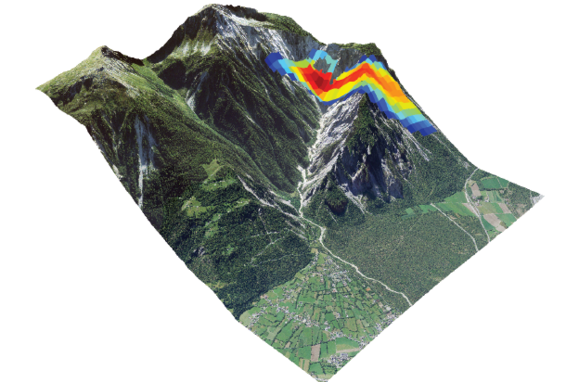A seismological study of mass movements
2017 - 2020

Mass movements, such as rockfalls, debris flows (a mixture of water, sediments and boulders), and ice avalanches, in steep mountain torrents have a highly destructive potential. As alternative to classical monitoring and early warning instrumentation, seismology - the study of ground motions induced by a force within the earth - allows monitoring of mass-movement-induced ground shaking at safe distance to rapidly detect and locate a flow front. The aim of this project is to better understand the dynamics and triggering mechanisms of mass movements in a changing climate.
Illgraben catchment in Switzerland's Canton Valais. Superimposed grid points with red colors indicate the seismology-derived location of a debris flow front recorded on 19 July 2011 [1]
Traditionally, seismology is associated with earthquakes, where ruptures in the earth crust release elastic energy in the form of seismic waves which then propagate through the earth. In recent years, a new field called „Environmental Seismology“ has evolved, which focuses on seismic signals generated by environmental forces at the earth surface. Advances in instrumentation size and portability allow only lately the deployment of seismometers in remote terrain. Utilizing the knowledge accumulated from decades of research in earthquake seismology, processes of mass movements can be monitored. The project mostly focuses on the Illgraben, a steep mountain catchment in the Valais, which is one of the most active mass wasting sites in Switzerland producing several debris flows per year. To study these, data from recent years as well as data from new deployments in sping/summer 2018 are used. In addition, other study sites are investigated for information on the influence of snow and ice on mass movement processes.
The three main goals of the project are:
- analysis of the process cascade defining mass movements
- early warning system of debris flows on real time seismic data
- numerical modeling of geophysical granular flows in combination with seismic data analysis to investigate rheological properties and effective friction
